The pull-up is the king of upper body exercises.
The pull-up is to the upper body what the squat is to the lower body. If you cannot yet perform a pull-up, you have some work to do.
In this post, you will learn how to do a pull-up correctly, and how to work your way up to one if you are a beginner.
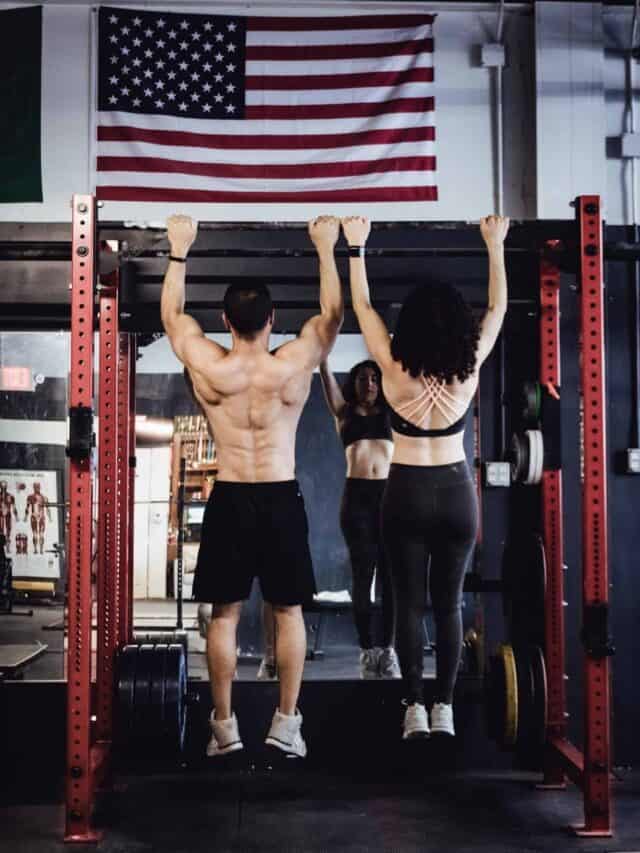
How To Do A Pull-Up Correctly (Form Video)
Benefits of The Pull-up
- Strengthens all of the back muscles including the latissimus dorsi, the rhomboids, the mid trapezius, and the posterior shoulders. It also strengthens your forearms, your grip, and your biceps.
- The hanging position improves overhead shoulder mobility.
- Requires very minimal equipment. Anything you can hang from is sufficient to train this large compound exercise.
- It is scalable to your level, as different variations provide varying levels of intensity
What Muscles Do Pull-ups Work?
The pull-up trains several arm and upper back muscles including:
- Latissimus Dorsi
- Rhomboids
- Posterior Deltoids
- Mid and Lower Traps (Trapezius muscle)
- Biceps
- Forearms/Grip
Pull-ups Vs Chin-Ups: Which Is Better?
The main difference between a pull-up and a chin-up is your grip. In a pull-up, your palms are pronated or facing forward. In a chin-up, your hands are supinated and facing you.
Chin-ups are easier than pull-ups for two reasons:
- they keep your arms in external rotation, which tends to be more comfortable for the shoulders.
- they recruit the bicep muscles more than pull-ups, increasing the number of muscles used to pull yourself up
You can use either variation, but it’s a good idea to become proficient in both.
How To Do A Pull-up Correctly
- Find a
pull-up bar that allows your entire body to be suspended in mid-air - If your feet touch the ground, or you have to bend your knees, the bar is too low
- Either jump up and grab the bar or use a box/bench to reach the bar
- Establish a grip that is slightly wider than shoulder-width with an overhand grip (your palms facing forward)
- You can wrap your thumbs around the bar, or have them above the bar. A full grip is stronger, but some may find the thumbs over grip more comfortable.
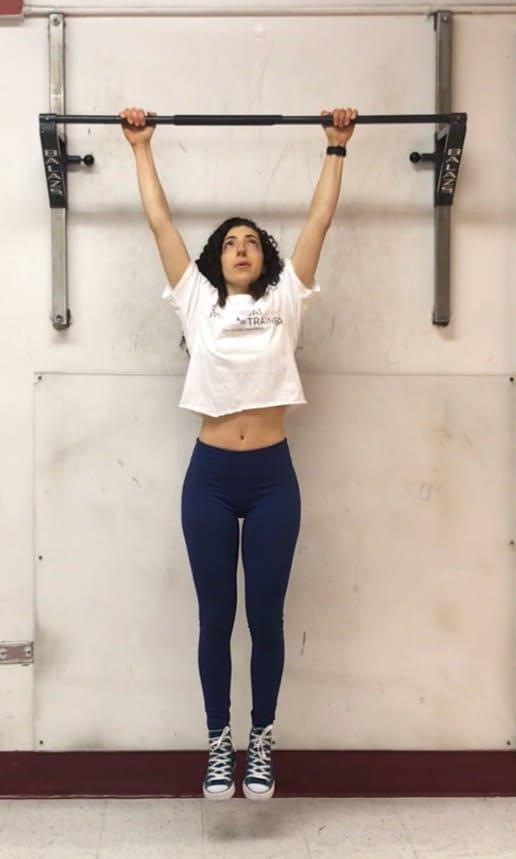
- From this position, keep your feet close together and pointed forward
- Then, externally rotate your shoulders so that they are screwed back into the shoulder sockets
- Take a big breath, squeeze your glutes and engage your core
- Begin pulling yourself up and focus on BRINGING YOUR CHEST TO THE BAR
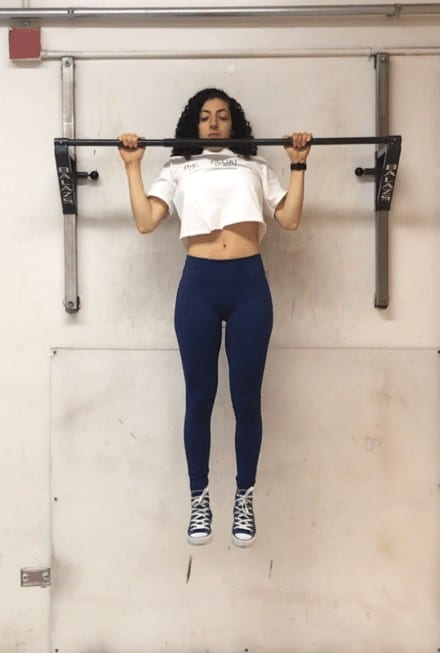
- Keep your head neutral – DO NOT THROW YOUR HEAD BACK to bring your chin over the bar
- If you cannot clear your chin over the bar, just stop and reverse back down
- You will reach the end range once your arms cannot bend anymore- your chin should naturally clear the bar at this point
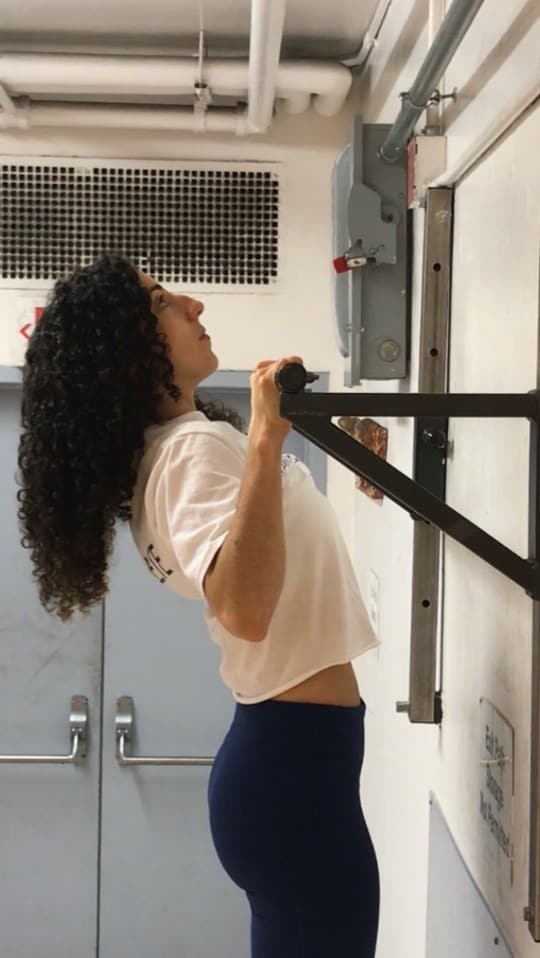
- Slowly lower yourself back down and repeat
The Best Exercise To Help Beginners With Their First Pull-up
One of the best exercises you can do to start building strength for your first pull-up is the pull-up negative (or eccentric pull-ups).
This exercise entails jumping up to the end range of a pull-up and slowly lowering yourself down in a controlled manner. See this video.
You can also start out with Horizontal Pull-ups, which is an easier variation. We have an entire tutorial on that exercise as well, which you can find here.
I do not recommend using the Assisted Pull-up Machine (where you rest your knees on a pad and it helps lift you)- This will throw your mechanics off as your knees are bent. Instead, have someone help support your feet or your legs to help you do the movement more naturally.
However, you can use resistance bands to help you as Brittany does in this video.
COMMON MISTAKES
Throwing Your Head Back To Complete The Movement
Throwing your head back to clear your chin is inefficient and will only cause neck strain.
The goal is not to get your chin over the bar. The goal of this exercise is to train your back muscles and your vertical pulling ability. If you cannot clear your chin, then stop and reverse the movement. * See the video above*
Letting Your Shoulders Internally Rotate
Shoulder internal rotation happens when your focus on trying to bring your chin over the bar without regard to your shoulder and spine position.
Lock your shoulders back into their sockets and concentrate on bringing YOUR CHEST to the bar. This will keep your shoulders in a healthy position.
Bending Your Knees Or Crossing Your Legs Behind You
This will throw your spinal alignment off and not allow you to activate or engage your core or your glute muscles.
Remember, the pull-up is a compound exercise that requires you to use as much of your body as possible.
Not Performing A Full-Range of Motion
When lowering yourself, go all the way down. Performing half repetitions is only cheating yourself from the benefits of this great exercise.
By The Way… The Pull-up is just one of several compound exercises you should be doing
To see a list of all the best exercises, be sure to check out our E-book that goes over all of the best compound movements for each body part!
We also go over them all in The Best Compound Exercises of All Time.
Other Related Questions
Why Can’t I Do A Pull-up?
The most common reasons for not being able to do a pull-up include:
- Lack of grip strength
- Lack of scapular strength
- Lack of upper back strength
The very first exercise to get good at are dead hangs. This exercise improves arm strength and develops your forearm muscles.
Second, focus on improving scapular strength by doing the scapular pull.
Third, train negative pull-ups like we show in the video above.
Lastly, focus on learning how to do chin-ups first (using an underhand grip).
How long does it take to do a proper pull-up?
It can take anywhere from 6-12 weeks to achieve your first pull-up depending on your starting strength level, body weight, and training routine.
The key is to train the vertical pull at least two times per week and the horizontal pull one to two times per week.
Why do my shoulders hurt when doing pullups?
Shoulder pain during pull-ups occurs when you allow your shoulders to internally rotate at the top of the movement. It is important to keep your shoulder blades back and down in the shoulder socket throughout the rep.
Also, make sure to use a slightly wider than shoulder width grip. A wide grip can place more stress on the shoulder joint.
How do I keep my shoulders down during pull-ups?
The best way to keep your shoulders down during a pull-up is to concentrate externally rotating your shoulders at the start of each repetition. Pretend as if you are trying to bend the pull-up bar in half and retract your shoulder blades.
Should you retract your scapula when doing pull-ups?
Yes, retracting your shoulder blades during pull-ups helps keep your shoulders externally rotated.
Should My elbows be tucked During pull-ups?
Yes, keeping your elbows tucked engages the upper back and keeps your shoulders in a healthy position.
Should you go all the way down on pull-ups?
In general, you should always use a full range of motion when doing compound exercises.
Doing half reps on the pull-up robs you of their full benefit.
Pull Up Alternatives
If you cannot do pull-ups with proper form, here are some other exercises to train your upper back.
Want to learn how to use the pull-up in your gym workouts?
Check out my full-body workout template!

Alex Robles, MD, CPT / Brittany Robles, MD, MPH, CPT
Alex & Brittany Robles are physicians, NASM Certified Personal Trainers, and founders of The White Coat Trainer: a resource dedicated to improving the health and fitness of busy professionals using time-efficient strategies. Their advice has been featured in My Fitness Pal, Prevention, Livestrong, Reader’s Digest, Bustle, The Active Times, and more. Learn more about them here.

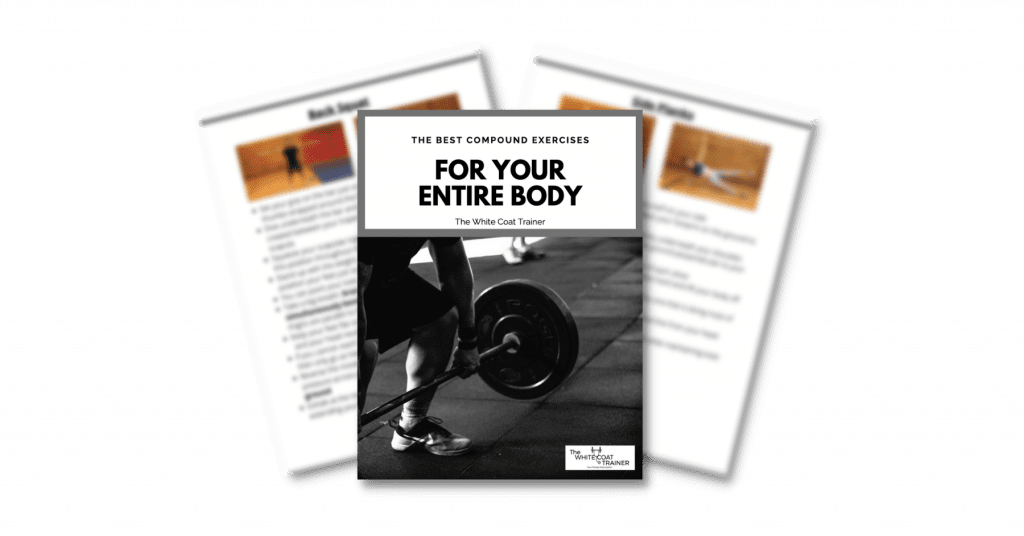
I’m ready to begin tomorrow a.m.
I do the commando pull ups as well.